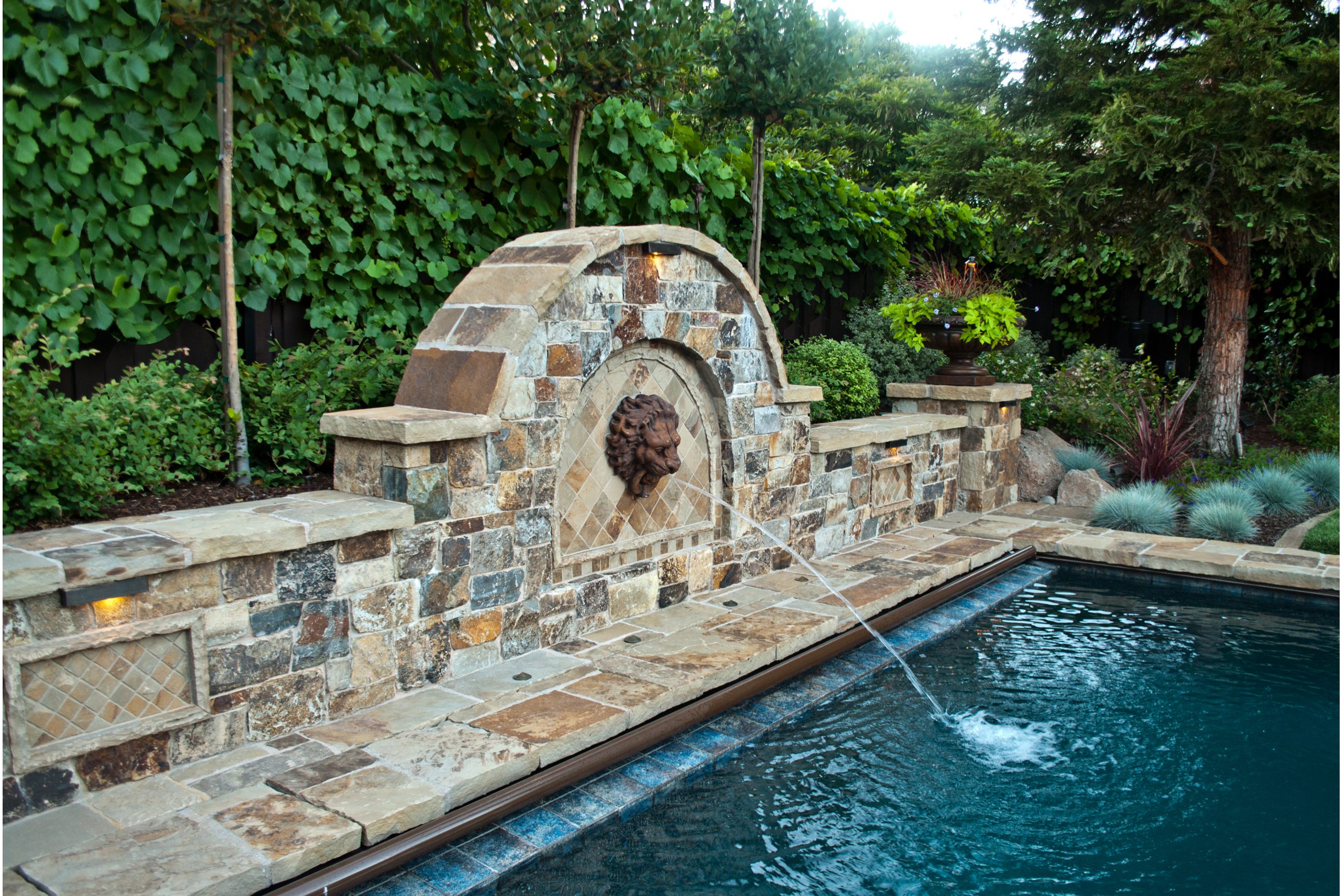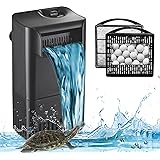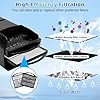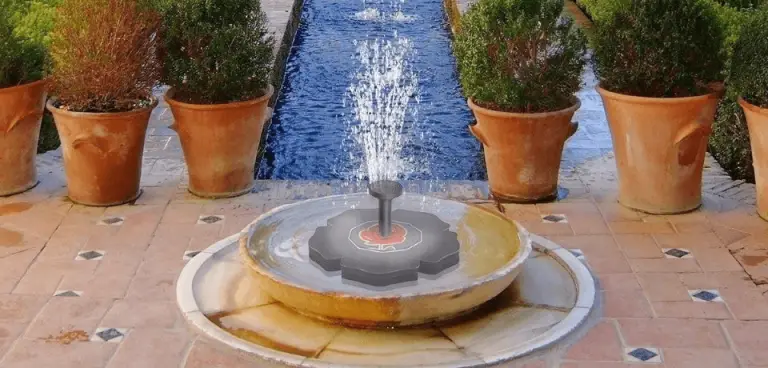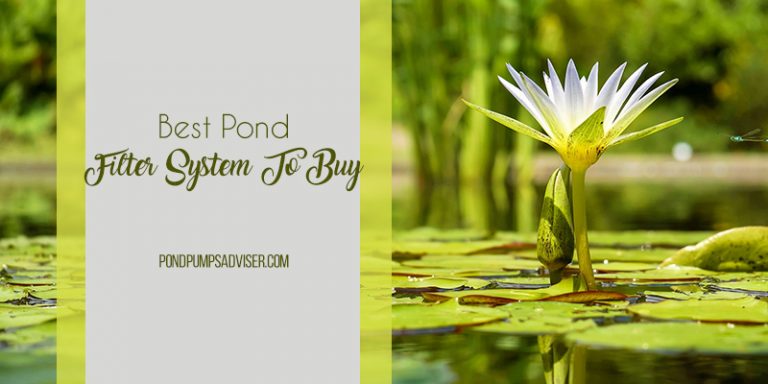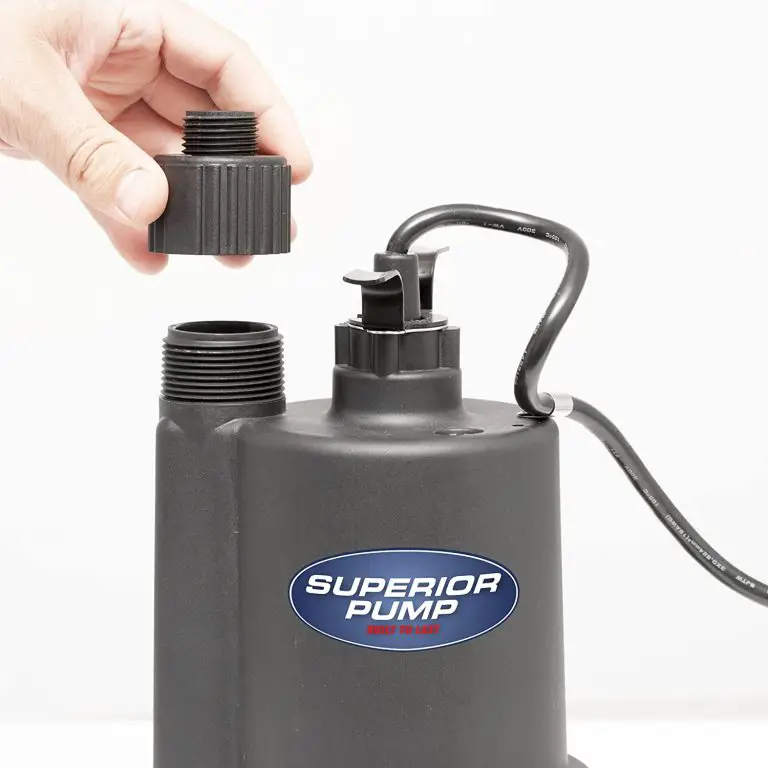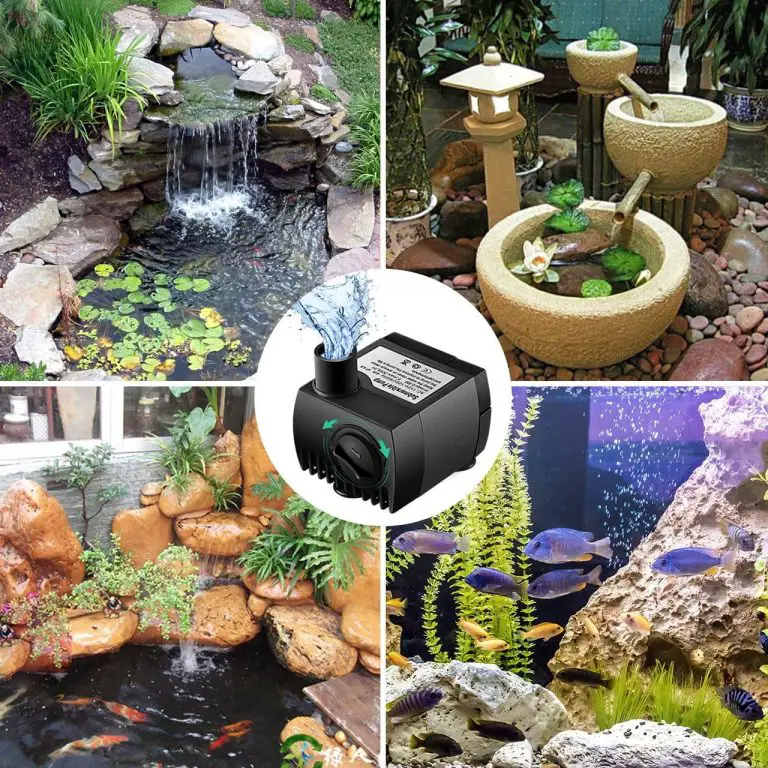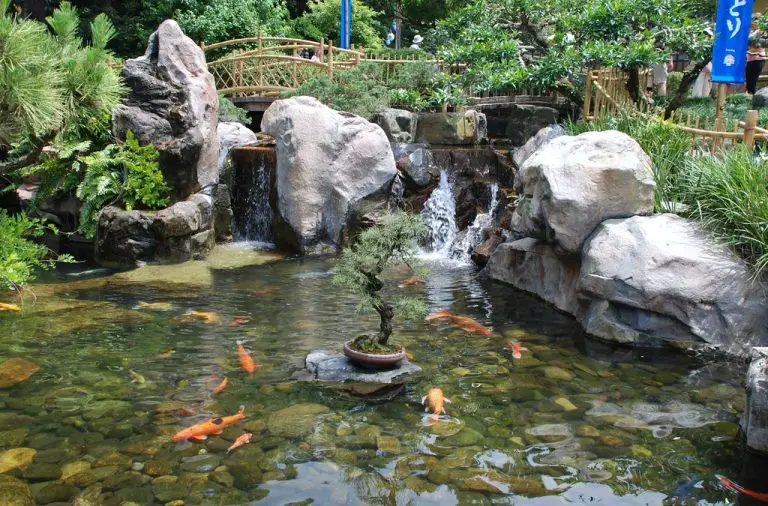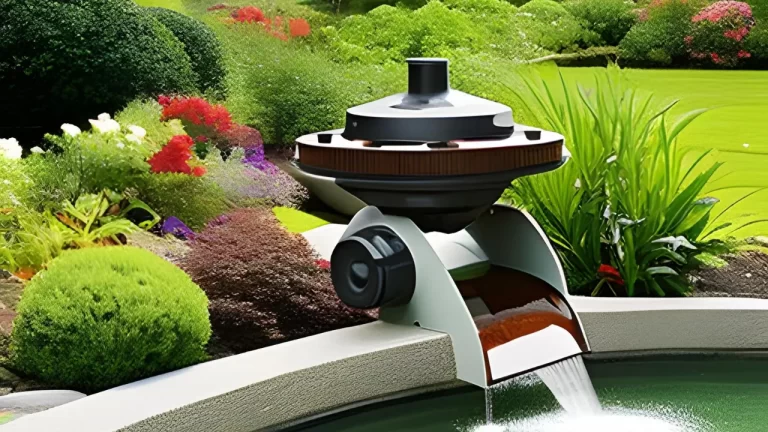Best 2000 GPH Pond Pump For Every Purpose
Turtle Tank Filter Aquarium Filter Power Adjustable 10-30 Gal. 222GPH Small Internal Filter 3-Stage Waterfall Bio-Filtration Low Water Level for Freshwater Saltwater Fish Tank Reptile Shrimp Frog
$26.99 ($26.99 / Count) (as of April 25, 2024 01:39 GMT +00:00 - More infoProduct prices and availability are accurate as of the date/time indicated and are subject to change. Any price and availability information displayed on [relevant Amazon Site(s), as applicable] at the time of purchase will apply to the purchase of this product.)In the tranquil world of water gardens and ponds, the silent hero often goes unnoticed. This hero, the pond pump, plays a pivotal role in maintaining the delicate balance of nature, ensuring that every droplet of water circulates with purpose. While the serene visuals of a pond or water garden captivate our senses, it’s the constant movement of water beneath the surface that keeps the ecosystem thriving. Stagnant water can quickly become a breeding ground for unwanted algae and insects, turning a peaceful oasis into a murky mess. But with the right pond pump, especially one with a 2000 GPH (gallons per hour) capacity, you can ensure optimal water circulation, enhancing the health of aquatic life and the overall aesthetics of your pond. As we delve deeper into the world of pond pumps, we’ll explore their significance, and types, and how to choose the best one for your needs.
Why is a Pond Pump Essential?
Water, in its stillness, can be mesmerizing. But when it comes to ponds and water gardens, stillness isn’t always golden. The continuous movement of water is not just about creating a soothing ripple effect or powering a picturesque waterfall; it’s about sustaining life and preserving beauty.
- Preventing Stagnation and Breeding Grounds: A pond without proper circulation can quickly become a haven for mosquitoes and other insects. These pests are not just annoying; they can also introduce diseases into your garden ecosystem. By ensuring a consistent flow of water, pond pumps disrupt the life cycle of these pests, keeping your pond insect-free.
- Ensuring Water Circulation and Freshness: Just like how our lungs need a constant supply of fresh air, aquatic life in ponds requires well-oxygenated water. A pond pump ensures that water is continuously moving, facilitating the exchange of oxygen and preventing the buildup of harmful gases. This circulation is crucial for the health and well-being of fish and beneficial bacteria.
- Supporting Additional Water Features: Beyond the essential health benefits, pond pumps also bring an element of charm to your water garden. Whether it’s a cascading waterfall, a bubbling fountain, or a gentle stream, these features are powered by the relentless work of the pond pump. These additions not only enhance the visual appeal but also create a melodious ambiance, making your garden a true retreat.
In essence, a pond pump is the heartbeat of any water garden, ensuring that every element, from the tiniest microorganism to the most majestic koi, thrives in harmony.
Types of Pond Pumps
At the heart of every pond or water garden, pond pumps come in various shapes, sizes, and functionalities. Understanding the different types is crucial to ensure you select the one that aligns perfectly with your pond’s needs. Let’s dive into the most common types:
- Submersible Pumps: As the name suggests, these pumps are designed to operate underwater, usually placed directly in the pond. They are popular for their ease of installation and quiet operation. Submersible pumps are ideal for smaller ponds and water features, as they can be easily concealed and don’t require external plumbing.
- Centrifugal Pumps: Often used for larger ponds or commercial applications, centrifugal pumps are external pumps that draw water from the pond and circulate it back after filtration. They are known for their durability, high flow rates, and ability to handle larger volumes of water. However, they might require a dedicated space and additional plumbing.
- Mag-Drive Pumps: A blend of efficiency and innovation, mag-drive or magnetic drive pumps operate without a direct-drive motor. Instead, they use magnets to generate movement, resulting in less friction and wear. This design makes them energy-efficient, reducing operational costs over time. They can be both submersible and external, offering flexibility in installation.
Each type of pump has its advantages and specific use cases. The key is to assess your pond’s requirements, size, and desired features to determine which pump aligns best with your vision.
How to Choose the Right Pond Pump
Choosing the perfect pond pump is akin to finding the heart that will sustain your water garden’s life and beauty. It’s not just about power or aesthetics; it’s about ensuring that every drop of water moves with purpose and efficiency. Here’s a guide to help you make an informed decision:
- Determine the Pond Size: Before diving into the world of pumps, it’s essential to know your pond’s volume. This can be calculated using the formula: Length x Width x Depth x 7.5 (for rectangular ponds). Knowing the volume will help you determine the required flow rate.
- Understand Flow Rate (GPH): The flow rate, measured in gallons per hour (GPH), indicates how much water the pump can circulate in an hour. For a healthy pond, aim for a pump that can circulate the entire pond’s volume at least once every two hours. For instance, a 4,000-gallon pond would ideally need a 2,000 GPH pump.
- Consider the Delivery Height: Also known as the ‘head height,’ it’s the vertical distance the pump needs to push water, especially relevant for waterfalls or fountains. Ensure the pump you choose can handle this height while maintaining the desired flow rate.
- Energy Efficiency Matters: An energy-efficient pump can save you significant amounts in the long run. Look for pumps with energy-saving features or those that operate using mag-drive technology.
- Durability and Maintenance: Opt for pumps made of corrosion-resistant materials and those with a design that minimizes clogging. A pump that’s easy to clean and maintain will ensure longevity and consistent performance.
- Additional Features: Some pumps come with added features like built-in UV clarifiers, adjustable flow controls, or thermal overload protection. While these might increase the initial cost, they can enhance the pump’s functionality and the overall health of your pond.
In essence, choosing the right pond pump is a balance between technical specifications and practical needs. By understanding your pond’s requirements and the features of various pumps, you can ensure a harmonious and vibrant water garden.
Our Top 3 Picks
1

Ultra-Quiet 550GPH Pump
2

Danner 3000 GPH Skimmer Pump
3

Efficient Pond & Water Pump
Reviews of Top 2000 GPH Pond Pumps
In the vast market of pond pumps, finding the ideal 2000 GPH pump can be a daunting task. To simplify your search, we’ve curated a list of top-performing pumps, highlighting their features, benefits, and potential drawbacks.

1
1- Aquascape 91017 Aqua Surge – 2000 GPH
9.8
Introducing the Aquascape Aqua Surge, a reliable and efficient pump designed for waterfall and skimmer systems. With a powerful flow rate of 2000 gph, this pump promises durability and silent operation, making it a top choice for pond enthusiasts.
Key Features
- High Flow Rate: Delivers a maximum water flow rate of 2000 gph.
- Versatile Use: Ideal for ponds, waterfalls, and other water-related applications.
- Durable Construction: Resistant to corrosion and rust, ensuring longevity.
- Asynchronous Motor: Offers more power and efficiency than standard pond pump motors.
- Adjustable Discharge: Easily modify the position of discharge to fit various pond shapes and sizes.
- Silent Operation: Rubber feet minimize vibrations, ensuring a noise-free experience.
- Continuous Use Design: Built for both vertical and horizontal applications.
What Other Reviewers Say
Many users have praised the Aquascape Aqua Surge for its durability and efficient performance. The silent operation is a recurring highlight, with many appreciating the noise-free experience. The pump’s versatility in fitting various pond sizes due to its adjustable discharge is also a notable feature. However, some users have mentioned the need for regular maintenance as it can clog easily.

2
2- Atlantic Water Garden TT2000
9.8
Meet the Atlantic Water Garden TT2000, a versatile and efficient pump tailored for those who seek functionality without compromising on space. Designed for both vertical and multifunctional use, this pump is a game-changer for water garden enthusiasts.
Key Features
- Efficient Performance: Delivers more water while consuming fewer watts, ensuring optimal energy usage.
- Compact Design: Fits effortlessly into narrow chambers, making it ideal for space-constrained setups.
- Asynchronous Motor: Enhances power and efficiency, outperforming many standard pond pump motors.
- Anti-Clogging Grills: Large grills prevent debris build-up, ensuring smooth operation and extended pump life.
- Versatile Use: Can be used both vertically and horizontally, adapting to various pond configurations.
What Other Reviewers Say
The Atlantic Water Garden TT2000 has garnered positive feedback from many users, particularly for its efficient performance and compact design. Its ability to fit into narrow spaces has been a highlight for many. The pump’s asynchronous motor is frequently praised for its power and efficiency. However, a few users have pointed out that if not installed correctly, the pump can be a bit noisy.

3
3- Danner 02650 Waterfall Pump, Black
9.8
Introducing the Danner 02650 Waterfall Pump – a perfect blend of durability and efficiency. Designed for those who prioritize both functionality and the safety of their aquatic life, this pump promises to be a game-changer for your pond or waterfall setup.
Key Features
- Submersible Design: Crafted to operate underwater, ensuring optimal performance.
- High Capacity: Tailored for large ponds, meeting high water flow demands.
- Ceramic Bearings: Offers reliability and efficiency with a flow rate of up to 2000 gph and a pumping height of 14 ft.
- Fish-Friendly: Oil-free operation ensures the safety of your aquatic life.
- Comprehensive Filtering: Comes with an effective filter and a spare, coupled with backflow valves for smooth water flow. Also features a 20-foot-long cord for flexibility in placement.
What Other Reviewers Say
Many users have praised the Danner 02650 for its durability and high performance. The oil-free design has been a hit among fish enthusiasts, ensuring the safety of their aquatic pets. While its efficiency is often highlighted, a few users have mentioned the cost of replacement parts as a downside. However, the overall consensus is that it’s a worthy investment for those looking for a reliable pond pump.

4
4- Growneer Submersible Pump
9.8
Meet the Growneer Submersible Pump, a harmonious blend of compact design and robust performance. For those who value quiet operation without compromising on efficiency, this pump emerges as an ideal choice. Its versatility and user-friendly features make it a standout in its category.
Key Features
- Adjustable Flow Rate: Comes with a control knob, allowing users to regulate the flow up to 2000 LPH.
- Durable Impeller: Crafted from stainless steel, ensuring longevity and resistance to wear.
- Versatile Nozzle Options: Equipped with three distinct nozzles, each with varying diameters, facilitating customizable water flow.
- Stable Operation: Features four suction cups, ensuring the pump remains securely in place, irrespective of its orientation.
- Efficient Motor: Designed for power-saving, making it a cost-effective choice
What Other Reviewers Say
The Growneer Submersible Pump has garnered appreciation for its adjustable flow rate and versatile nozzle options. Users have lauded its stability, thanks to the suction cups, and its durable impeller design. While its efficiency and versatility are frequently highlighted, a minor point of contention has been its noise level. However, the overall sentiment suggests that it offers good value for its price.
Frequently ask Questions About Pond Pumps
Why is my pond pump not working?
There could be several reasons, including electrical issues, blockages in the pump, or wear and tear. Always ensure the pump is connected to a power source, check for debris, and consider the pump’s age. If it’s old, it might be time for a replacement.
How often should I clean my pond pump?
Depending on the pump’s design and your pond’s environment, cleaning can range from once a month to once every few months. Pumps in ponds with a heavy debris load may require more frequent cleaning.
Is it okay to run my pond pump continuously?
Yes, most pond pumps are designed to run 24/7. Continuous operation ensures consistent water circulation, which is beneficial for the pond’s ecosystem.
Can I use a pond pump for a waterfall or fountain?
Absolutely! Ensure you choose a pump with the appropriate flow rate and head height to effectively power your waterfall or fountain.
How do I determine the right size pump for my pond?
As a general rule, your pump should circulate the pond’s entire volume at least once every two hours. Measure your pond’s volume and choose a pump with a GPH (gallons per hour) rating that aligns with this requirement.
Are energy-efficient pumps worth the investment?
Definitely. While they might have a higher upfront cost, energy-efficient pumps can lead to significant savings in electricity bills over time, making them a cost-effective choice in the long run.
Conclusion
The gentle hum of a pond pump, often overshadowed by the mesmerizing beauty of a water garden, is a testament to its indispensable role. From ensuring the well-being of aquatic life to powering captivating water features, the right pond pump breathes life into every corner of your pond. As we’ve journeyed through the intricacies of pond pumps, from their types to their significance, one thing stands clear: the heart of a pond, much like our own, must be chosen with care, understanding, and foresight.
In a market flooded with options, armed with the knowledge from this guide, you’re now equipped to make an informed choice. Whether you’re setting up a new pond or rejuvenating an old one, remember that the right pump can transform your water garden from a stagnant pool into a thriving oasis. Here’s to clear waters, happy fish, and the soothing sounds of nature!
Buying Guide: Choosing the Perfect Pond Pump
Selecting the right pond pump goes beyond just technical specifications. It’s about understanding your pond’s unique needs and ensuring that the pump you choose aligns seamlessly with your vision. Here’s a quick guide to help you make the best purchase:
Determine Your Needs
- Pond Size: Measure your pond’s volume. This will be crucial in determining the required flow rate.
- Water Features: Do you have or plan to install a waterfall, fountain, or stream? Ensure the pump can handle the additional requirements.
Understand the Specifications
- Flow Rate (GPH): Ideally, the pump should circulate the entire pond’s volume at least once every two hours.
Head Height: If you have elevated water features, ensure the pump can push water to the required height.
Energy Efficiency
- Consider pumps that offer energy-saving features. They might cost more upfront but can lead to significant savings in the long run.
Durability and Warranty
- Opt for corrosion-resistant materials.
- Check the warranty period and what it covers.
Ease of Maintenance
- Pumps that are easy to clean and maintain will ensure longevity and consistent performance.
Noise Level
- If your pond is in a quiet area, consider pumps known for silent operation.
Safety Features
- Look for pumps with thermal overload protection or auto shut-off features to prevent damage.
Read Reviews
- Go through customer reviews to get insights into the pump’s performance, durability, and potential issues.
Budget
- While it’s essential to invest in a quality pump, ensure it aligns with your budget. Remember, the most expensive option isn’t always the best.
Consult Experts
If in doubt, consult with pond specialists or retailers who can provide personalized recommendations based on your specific needs.
